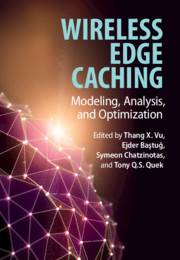Book contents
- Frontmatter
- Contents
- List of Contributors
- Preface
- 1 Introduction
- Part I Optimal Cache Placement and Delivery
- Part II Proactive Caching
- Part III Cache-Aided Interference and Physical Layer Management
- Part IV Energy-Efficiency, Security, Economic, and Deployment
- 15 Energy-Efficient Deployment in Wireless Edge Caching
- 16 Cache-Enabled UAVs in Wireless Networks
- 17 Physical Layer Security for Edge Caching Wireless Networks
- 18 Mobile VR Edge Delivery: Computing, Caching, and Communication Trade-Offs
- 19 Economic Ecosystems in Elastic Wireless Edge Caching
- Index
15 - Energy-Efficient Deployment in Wireless Edge Caching
from Part IV - Energy-Efficiency, Security, Economic, and Deployment
Published online by Cambridge University Press: 19 October 2020
- Frontmatter
- Contents
- List of Contributors
- Preface
- 1 Introduction
- Part I Optimal Cache Placement and Delivery
- Part II Proactive Caching
- Part III Cache-Aided Interference and Physical Layer Management
- Part IV Energy-Efficiency, Security, Economic, and Deployment
- 15 Energy-Efficient Deployment in Wireless Edge Caching
- 16 Cache-Enabled UAVs in Wireless Networks
- 17 Physical Layer Security for Edge Caching Wireless Networks
- 18 Mobile VR Edge Delivery: Computing, Caching, and Communication Trade-Offs
- 19 Economic Ecosystems in Elastic Wireless Edge Caching
- Index
Summary
Edge-caching has received much attention as an efficient technique to reduce delivery latency and network congestion during peak-traffic times by bringing data closer to end users. Existing works usually design caching algorithms separately from physical layer design. In this chapter, we analyze edge-caching wireless networks by taking into account the caching capability when designing the signal transmission. Particularly, we investigate multi-layer caching, where both base station (BS) and users are capable of storing content data in their local cache and analyze the performance of edge-caching wireless networks under two notable uncoded and coded caching strategies. Wefirst calculate backhaul and access throughputs of the two caching strategies for arbitrary values of cache size. The required backhaul and access throughputs are derived as a function of the BS and user cache sizes. Then closed-form expressions for the system energy efficiency (EE) corresponding to the two caching methods are derived. Based on the derived formulas, the system EE is maximized via a precoding vectors design and optimization while satisfying a predefined user request rate. Two optimization problems are proposed to minimize the content delivery time for the two caching strategies.
Keywords
- Type
- Chapter
- Information
- Wireless Edge CachingModeling, Analysis, and Optimization, pp. 303 - 321Publisher: Cambridge University PressPrint publication year: 2021

